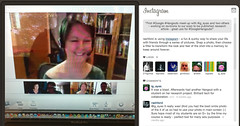Warning: Trying to access array offset on value of type bool in /home/bohemica/public_html/techczech.net/wp-content/plugins/slideshare/slideshare.php on line 162
Warning: Trying to access array offset on value of type bool in /home/bohemica/public_html/techczech.net/wp-content/plugins/slideshare/slideshare.php on line 165

I’ve been using GoToMeeting (GTM) and GoToWebinar (GTW) for three years now, so I thought, it’s time to share some experiences. Citrix has been very slow to innovate so I have been looking for alternatives but so far have not found the perfect one to justify the hassle of switching.
Contents
Why GoToWebinar
So let’s start with the good stuff.
- Registrations and reminders are definitely high on the list of things to like. I’ve missed many a webinar on Webex, Adobe Connect and Blackboard Collaborate because their registration systems are just not good enough. GTW sends the attendee a reminder with a customized link for direct login the day before and an hour before. Works like a charm.
- Polls are also a great feature for interacting with the audience.
- No downloads of plugins is also very nice. It mostly just works out of the box. The attendee clicks a link and in a few minutes, they’re in the webinar. With some exceptions below.
- Simple interface is another strong point of GTW. Very few things to click. Presenters don’t have to upload anything, just share the screen and go. But there is room for improvement (see below).
- Attendees can phone in as well as use VoIP which is still very useful despite ever greater broadband penetration
- You also get one GoToMeeting account with your GTW subscription.
- Transparent pricing (with one exception below) is probably the strongest point. All the other commercial alternatives give you the run around before letting you know how much which service costs. GTW tells you the first thing. Now, whether prices are still a good deal is another questions.
- Flat fees make running webinars a worry free experience. You don’t have to worry about cost overruns or how many webinars you organize.
What’s missing in GoToWebinar
As I said, Citrix is not very quick at innovating with new features. A lot of these have been missing for years and the company doesn’t communicate very well about their road plans.
- Recording of webinars is almost unusable. I get random failures on Windows 7 (and you don’t know if it’s going to fail until the end) but even if it succeeds, the format is hard to edit in commercial applications and the audio quality is shameful. So I use Camtasia to record the screen with the system audio and that seems to work well as long as you don’t click anything or type while doing it. So I generally do it on a third computer via LogmeIn.
- You cannot demote participants after you’ve given them extra privileges. Sometimes, I’d like to have an attendee show their screen for a moment, which works. But once I’ve done that, they are stuck as Panelist even though I want to bump them back to attendee so that they cannot have all the Panelist privileges like seeing the Panelist chat. Another problem is that once they are a Panelist they can no longer raise their hand as other users so they cannot ask to be unmuted.
- Panelists cannot chat after the webinar ended because there’s no feature to finish the webinar for everyone but the Panelists or Organizers. That’s really annoying and unfriendly to organizers working with external speakers.
- There is no open chat back-channel for attendees which means all the communication is between the attendee and the speakers. That’s really backward of Citrix and I suspect they’re only doing this to drive customers to GoToTraining which when I tried it, was a really mediocre service not worth the money.
- The interface is in two parts which negates some of the good points about simplicity. There’s a viewer and a control panel. It would be much easier if the control panel was docked to the viewer which is the standard on all other platforms. It would save the organizer a lot of explaining.
- There is no way for participants to check if GTW works on their system ahead of time. As I said, it mostly works but when it doesn’t, you don’t find out until it’s too late. The organizer cannot give support to these people with problems and very often doesn’t even find out about them. MacOS had trouble for a while but that info was buried deep inside some FAQ.
- There’s no way to have more complex interaction with the audience. The polls and questions are nice but there should be so much more by now. At least a way to collate one word responses away from the Q&A interface. It’s confusing to participants if they have to type answers to the box labelled Question. Ideally, I’d like to put up a textbox for them to fill out when I ask an open ended question.
- No Linux compatibility is generally not a problem until you try to work with web developers. I know at least one company that switched to WebEx because of this, and I got a lot of flak when I ran a webinar about open source.
- The lack of breakout sessions is a real downside over other solutions. Citrix try to push you towards GoToTraining for that but I don’t want another product. I want this product to work the way I want. If it was an extra feature to pay for, that would be fine. But a whole other service just for this is not on.
- There is no presenter video still! Last year, Citrix introduced video to GoToMeeting where I almost never use it but it’s still missing from GoToWebinar where I’d use it a lot. I understand the technical difficulties and, ultimately, it’s a relatively small problem. People just listen to the speaker and watch the screen presentation or screen sharing but it would be nice at the start and during Q&A sessions where nothing much is going on the screen.
- Mobile apps are not available to attend or host a webinar. This is possible with GTM, so maybe, the functionality will eventually migrate to webinars, as well.
- New pricing tiers make me question whether GTW is still such a good deal. The old plans gave you up to 1000 attendees for one price. Now, you’d shell out five times as much which puts it out of reach for many organizations. The problem is that I use GTW a lot but only have a larger even four times a year. Also, I may get over 500 sign ups but never more than about 200-300 attendees. In this case, I would prefer to get billed extra per one off event, rather than be clobbered by a price that will be peanuts to an organization that runs these large events every week.
What are the alternatives
There are literally dozens of alternatives to GTW. I’ve explored some of the bigger ones in depth. Here are some notes from my research.

- Google Hangouts on Air is not really a full alternative to GTW but it’s free and a good solution if you want to broadcast seminars to large numbers of people for free. The interaction options with the audience are minimal, require a YouTube account, and are hard for panelists for follow. Also, there’s no scheduling or registrations (yet) but it’s easy to set up a page just for that. In some scenarios, it may also be a problem that it does not allow a landline phone in. There is some limited and cumbersome support but not as easy as giving someone a number to call in on. On the other hand, the instant recording and publishing on YouTube is very appealing. Probably the best solution, if video is really important and the other things don’t matter. The screensharing also works very well.
- WebEx is probably the biggest competitor to GTW. It is run by the other giant in networking Cisco, and has a very similar feature set. The new offering is very compelling (but not clear on the pricing) and I’ve found the interface a bit confusing as an attendee. But they run on Linux, which is definitely a selling point. On the meeting side of things, WebEx offers free meetings for up to 3 people.
- AdobeConnect was another one I’ve tried when I was first making the decision and was put off by its reliance on flash. It seems to have improved now and the interface is nice and simple. But it launches in a weird way and I just joined a webinar that was over but there was no indication of what was happening. Like WebEx, Adobe offers free meetings for up to 3 people.
- Blackboard Collaborate formerly Elluminate is a worthy competitor. The interface is a bit dated but workable. It’s always had presenter video and break out rooms. But since Blackboard took it over, it’s not clear how much it costs and Blackboard has closed many services Elluminate used to offer. But it’s a service a lot of universities still use.
- Instant presenter is used by a several organizations I know. The functionality and interface are limited. But it does allow presenter video and open chat by attendees. Both as presenter and attendee, I found the interface limited and not very user friendly but ultimately workable. The prices are about the same as for GTW.
- BigBlueButton is one of the few Open Source platforms left since the purchase of DimDim by Salesforce. This should be a good solution for institutions with their own server space and ample bandwidth like universities. There are commercial providers out there, as well, but the ecosystem is quite small. I’ve seen a few demos and it is an impressive system with pretty much all the features you might need in a computer only system. A public demo version is available to try out.
- Slideshare’s Zipcasts offered some early promise when they were free to try but seem quite limited for the money now that they are a premium only service.
- Some other names I’ve come across include FuzeMeeting, TalkFusionLive, and many many more. I’m sure all have the odd nice feature and loyal user base. But there’s only so much research one can do. There is also some confusion sometimes about the extent of the services offered ranging from screen sharing, online meetings to video conferencing and webinars.
Note on accessibility
I have not done full testing, but none of these services seem to be fully keyboard navigable and accessible to screen readers. Some of this is inevitable by their nature but some is just by omission. This makes the support of phone in all the more important.
Conclusion
I would really like Citrix to fix some of the issues in GTW, I’ve submitted requests, but I hold out little hope of change. However, for now, there is not a compelling enough alternative to make a switch. GTW is a very good product at a reasonable price (depending on your usage patterns) so, if you’re making a decision, it will serve you well. This post will have outlined the strengths and weaknesses, as well as some alternatives. Let me know how you get on.
Blast from the past
Two years ago, I presented at a MoodleMoot on how we use GTW to supplement e-learning. Here’s the presentation. It’s still fairly current.

